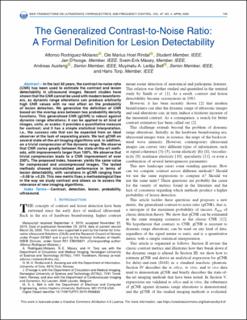| dc.contributor.author | Molares, Alfonso Rodrígues | |
| dc.contributor.author | Rindal, Ole Marius Hoel | |
| dc.contributor.author | D´Hooge, Jan | |
| dc.contributor.author | Måsøy, Svein-Erik | |
| dc.contributor.author | Austeng, Andreas | |
| dc.contributor.author | Bell, Muyinatu A. Lediju | |
| dc.contributor.author | Torp, Hans | |
| dc.date.accessioned | 2021-01-26T07:48:28Z | |
| dc.date.available | 2021-01-26T07:48:28Z | |
| dc.date.created | 2020-04-21T11:00:11Z | |
| dc.date.issued | 2020 | |
| dc.identifier.citation | IEEE Transactions on Ultrasonics, Ferroelectrics and Frequency Control. 2020, 67 (4), 745-759. | en_US |
| dc.identifier.issn | 0885-3010 | |
| dc.identifier.uri | https://hdl.handle.net/11250/2724647 | |
| dc.description.abstract | In the last 30 years, the contrast-to-noise ratio (CNR) has been used to estimate the contrast and lesion detectability in ultrasound images. Recent studies have shown that the CNR cannot be used with modern beamformers, as dynamic range alterations can produce arbitrarily high CNR values with no real effect on the probability of lesion detection. We generalize the definition of CNR based on the overlap area between two probability density functions. This generalized CNR (gCNR) is robust against dynamic range alterations; it can be applied to all kind of images, units, or scales; it provides a quantitative measure for contrast; and it has a simple statistical interpretation, i.e., the success rate that can be expected from an ideal observer at the task of separating pixels. We test gCNR on several state-of-the-art imaging algorithms and, in addition, on a trivial compression of the dynamic range. We observe that CNR varies greatly between the state-of-the-art methods, with improvements larger than 100%. We observe that trivial compression leads to a CNR improvement of over 200%. The proposed index, however, yields the same value for compressed and uncompressed images. The tested methods showed mismatched performance in terms of lesion detectability, with variations in gCNR ranging from -0.08 to +0.29. This new metric fixes a methodological flaw in the way we study contrast and allows us to assess the relevance of new imaging algorithms. | en_US |
| dc.language.iso | eng | en_US |
| dc.publisher | Institute of Electrical and Electronics Engineers (IEEE) | en_US |
| dc.rights | Navngivelse 4.0 Internasjonal | * |
| dc.rights.uri | http://creativecommons.org/licenses/by/4.0/deed.no | * |
| dc.title | The Generalized Contrast-to-Noise Ratio: A Formal Definition for Lesion Detectability | en_US |
| dc.type | Peer reviewed | en_US |
| dc.type | Journal article | en_US |
| dc.description.version | publishedVersion | en_US |
| dc.source.pagenumber | 745-759 | en_US |
| dc.source.volume | 67 | en_US |
| dc.source.journal | IEEE Transactions on Ultrasonics, Ferroelectrics and Frequency Control | en_US |
| dc.source.issue | 4 | en_US |
| dc.identifier.doi | 10.1109/TUFFC.2019.2956855 | |
| dc.identifier.cristin | 1807275 | |
| dc.relation.project | Norges forskningsråd: 237887 | en_US |
| dc.description.localcode | This work is licensed under a Creative Commons Attribution 4.0 License. For more information, see https://creativecommons.org/licenses/by/4.0/ | en_US |
| cristin.ispublished | true | |
| cristin.fulltext | original | |
| cristin.qualitycode | 1 | |

